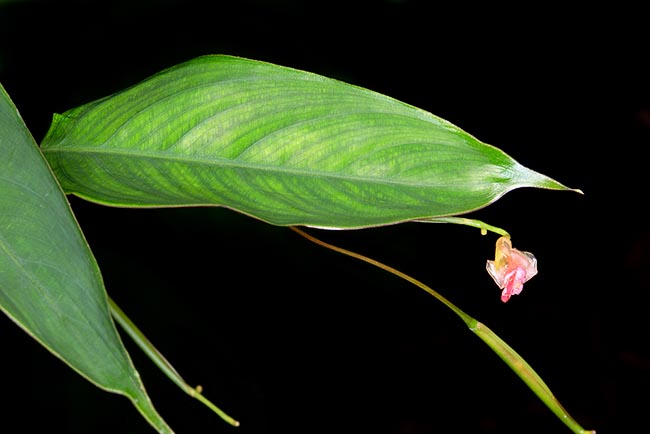Family : Marantaceae

Text © Pietro Puccio

English translation by Mario Beltramini

Marantochloa filipes is a rhizomatous herbaceous species of tropical West Africa, even 2 m tall, with asymmetrical leaves compared to the central rib. The flowers are the smallest in the genus Marantochloa © Giuseppe Mazza
The generic name is the combination of Maranta, genus honoured to the Italian physician and botanist Bartolomeo Maranta (1500-1571), and of the Greek substantive “χλόη” (chloe) = grass; the specific name is the combination of the Latin substantives “filium, i” = thread and “pes, pedis” = foot with reference to the thin stems.
Common names: ndouhrou (Cameroon); gblissi (Ivory Coast); fita, fitta, hita, uma (Nigeria); ka-tent, teud (Sierra Leone); mbili, mosobo (Central African Republic).
The Marantochloa filipes (Benth.) Hutch. (1936) is a perennial rhizomatous herbaceous species, evergreen, forming up to 2 m tall tufts with thin ramified stems. The leaves, on a 6-10 cm long petiole, are alternate, simple, ovate to oblong-lanceolate with long pointed apex, not in line with the central nervation, and entire margin, asymmetrical in respect to the central nervation, 7-15 cm long and 3-7 cm broad, coriaceous, of dark green colour above, waxy below. Terminal inflorescence, 16-20 cm long, racemose, provided with green bracts subtending hermaphroditic flowers, about 1 cm long, of white and pink colour with 3 lanceolate sepals with pointed apex, 3 lanceolate petals, stamen and staminodes arranged in two verticils, the inner one formed by the fertile stamen and by one staminode, the outer one by two unequal petaloid staminodes. The fruit is a globose capsule of 0,7 cm of diameter, pink to red when ripe, containing three glossy blackish trigonous seeds with fleshy aril of orange red colour.
It reproduces by seed, in draining organic loam maintained constantly humid at the temperature of 24-26 °C, and easily by division. Species cultivable in the tropical and humid subtropical climate regions in preferably semi-shaded position and without particular exigencies concerning the soil, provided draining and maintained constantly humid, but without stagnations. The species is part of the diet of the gorillas and the chimpanzees.
Synonyms: Phrynium filipes Benth. (1849); Clinogyne filipes (Benth.) Benth. & Hook.f. (1883); Arundastrum filipes (Benth.) Kuntze (1891); Donax filipes (Benth.) K.Schum. (1892); Donax oligantha K.Schum. (1892); Clinogyne oligantha (K.Schum.) K.Schum. (1897); Clinogyne eburnea A.Chev. (1920); Marantochloa oligantha (K.Schum.) Milne-Redh. (1950).
